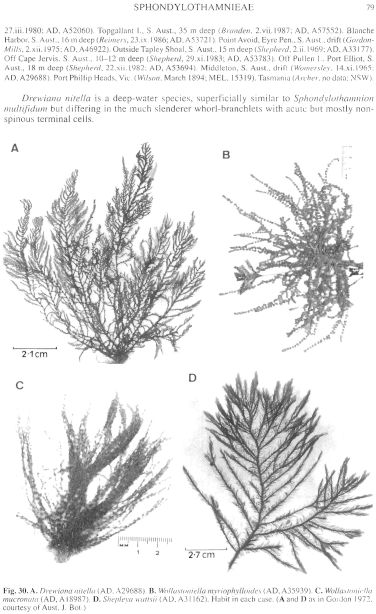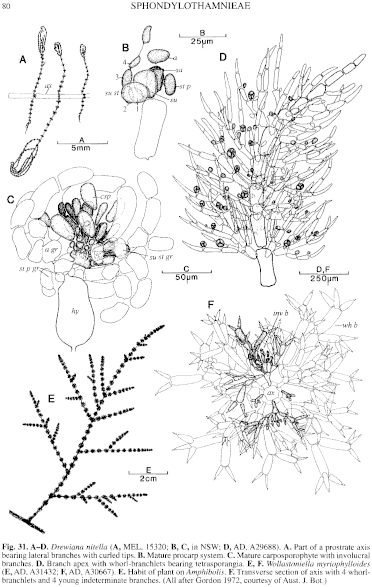|
|
|
|
|
|||||||||||
|
Electronic Flora of South Australia Species Fact Sheet
Phylum Rhodophyta – Order Ceramiales – Family Ceramiaceae – Tribe Sphondylothamnieae
Selected citations: Huisman & Walker 1990: 426.
Synonym
Wrangelia myriophylloides Harvey 1855a: 546; 1862: pl. 224; 1863, synop.: xxviii. J. Agardh 1876: 617. De Toni 1897: 128. Lucas 1909: 22; 1929b: 48. Lucas & Perrin 1947: 136. May 1965: 365. Mazza 1906: No. 40. Reinbold 1897:47; 1899:44. Sonder 1881: 28. Tate 1882: 21. Tisdall 1898: 511. Womersley 1950: 181; 1953: 38.
Thallus (Fig. 30B) dark red-brown, fading to grey, 10–15 (–20) cm high, main branches irregularly alternate, often sparse and divergent, for 2–4 orders. Base of axes often prostrate and entwined, forming a matted holdfast attached by haptera; usually epiphytic on Amphibolis, fucoids or geniculate coralline algae. Structure. Subapical cells producing 3–4 whorl - branchlets (Fig. 31F) in circular sequence, axial cells enlarging to 300–350 µm in diameter and 2–3.5 mm long in lower axes; primary axes of whorl-branchlets 4 cells long, terminal cells maturing first and lower laterals produced basipetally; terminal cells short and mucronate, median cells 120–200 µm in diameter and L/D 3–5. Adjacent whorls (Fig. 31E) of whorl-branchlets become separated with 0.5–2.5 mm of the axial cell exposed between them. Indeterminate branches (up to 4 from each axial cell) produced in addition to whorl-branchlets (Fig. 31F). Cortication by rhizoids from lower axes, produced from lower ends of axial cells, forming haptera from the proximal ends of the rhizoidal cells (Fig. 32A). Cells multinucleate; rhodoplasts discoid.
Reproduction: Gametophytes dioecious. Female axes (Fig. 32B) 5–6 cells long, up to 4 such axes alternating with whorl-branchlets on potentially indeterminate branches, with the last 4 cells relatively small and densely protoplasmic. The subapical cell bears 2 sterile pericentral cells and the supporting cell which bears a terminal sterile cell and a lateral carpogonial branch; the hypogenous and subhypogenous cells are without laterals (Fig. 32B). Post-fertilization, 2 connecting cells are formed and the auxiliary cell produces gonimoblast initials which divide and form clavate carposporangia 60–100 µm in diameter; carposporophyte (Fig. 32C) 450–1100 µm across; lower gonimoblast cells and sterile procarp cells fuse to form a relatively large multinucleate fusion cell, and the apical cell, the 2 sterile pericentral cells and the sterile cell on the supporting cell divide to form 4 inner involucral filaments. Spermatangial heads (Fig. 32D) are subspherical, 90–110 µm in diameter, sessile and adaxial on cells of villose whorl-branchlets.
Tetrasporangia (Fig. 32E) occur terminally and laterally on small cells of much branched whorl-branchlets, borne just below the apex of short indeterminate branches; tetrasporangia are 100–160 µm in diameter, tetrahedrally divided (rarely octosporangia).
Type from Rottnest I., W. Aust. (Harvey); holotype in Herb. Harvey, TCD (Tray. Set 246).
Selected specimens: Port Denison, W. Aust., drift (Gordon, 8.xi.1968; AD, A32180). Hamelin Bay, W. Aust., drift (Womersley, 1.ix.1979; AD, A50605). Eucla, W. Aust., drift (Gordon, 5.xi.1968; AD, A33961). Elliston, S. Aust., drift (Parsons, 23.viii.1967; AD, A31432). Avoid Bay, S. Aust., on Scaberia, drift (Womersley, 30.xi.1975; AD, A46847). Tiparra Reef, S. Aust., on Amphibolis, 11 m deep (Shepherd, 5.xi.1971; AD, A38330), and 5–6 m deep (Shepherd, 24.xi.1970; AD, A35939). Cable Hut Bay, Yorke Pen., S. Aust., on Scaberia, drift (Gordon, 23.ix.1968; AD, A32167). D'Estrees Bay, Kangaroo I., S. Aust., on Haliptilon, drift (Womersley, 11.i.1950; AD, Al2731, Al2732). Pennington Bay, Kangaroo I., S. Aust., drift (Womersley, 4.i.1948; AD, A6619). Kingston, S. Aust., on Amphibolis, drift (Womersley, 20.v.1964; AD, A27888) and (Gordon, 19.viii.1966; AD, A30667). Cape Thomas, S. Aust., on Amphibolis, drift (Womersley, 24.v iii.1960; AD, A24394). Queenscliff, Vic. (Mueller; MEL, 15333).
Distribution: Port Denison, W. Aust., to Port Phillip, Victoria.
Taxonomic notes: W. myriophylloides is a moderately deep water alga, usually epiphytic on Amphibolis or larger algae. The habit and robust glomerules of whorl-branchlets with mucronate end cells are distinctive.
References:
AGARDH, J.G. (1876). Species Genera et Ordines Algarum. Vol. 3, Part 1- Epicrisis systematic Floridearum, pp. i-vii, 1–724. (Weigel: Leipzig.)
DE TONI, G.B. (1897). Sylloge Algarum omnium hucusque Cognitarum. Vol. 4. Florideae. Sect. 1, pp. 1–388. (Padua.)
GORDON, E.M. (1972). Comparative morphology and taxonomy of the Wrangelieae, Sphondylothamnieae and Spermothamnieae (Ceramiaceae, Rhodophyta). Aust. J. Bot. suppl. 4, 1–180.
HARVEY, W.H. (1855a). Some account of the marine botany of the colony of Western Australia. Trans. R. Jr. Acad. 22, 525–566.
HARVEY, W.H. (1862). Phycologia Australica. Vol. 4, Plates 181–240. (Reeve: London.)
HARVEY, W.H. (1863). Phycologia Australica. Vol. 5, Plates 241–300, synop., pp. i-lxxiii. (Reeve: London.)
HUISMAN, J.M. & WALKER, D.I. (1990). A catalogue of the marine plants of Rottnest Island, Western Australia, with notes on their distribution and biogeography. Kingia 1, 349–459.
LUCAS, A.H.S. & PERRIN, F. (1947). The Seaweeds of South Australia. Part 2. The Red Seaweeds. (Govt Printer: Adelaide.)
LUCAS, A.H.S. (1909). Revised list of the Fucoideae and Florideae of Australia. Proc. Linn. Soc. N.S.W. 34, 9–60.
LUCAS, A.H.S. (1929b). A census of the marine algae of South Australia. Trans. R. Soc. S. Aust. 53, 45–53.
MAY, V. (1965). A census and key to the species of Rhodophyceae (red algae) recorded from Australia. Contr. N.S.W. natn. Herb. 3, 349–429.
MAZZA, A. (1906). Saggio di Algologia Oceanica. Nuova Notarisia 17, Nos. 32–100.
REINBOLD, T. (1897). Die Algen der Lacepede und Guichen Bay und deren näherer Umgebung (Süd Australien), gesammelt von Dr. A. Engelhart-Kingston. Nuova Notarisia 8, 41–62.
REINBOLD, T. (1899). Meeresalgen von Investigator Street (Slid Australien), gesammelt von Miss Nellie Davey (Waltham, Honiton). Hedwigia 38, 39–51.
SONDER, O.W. (1881). In Mueller, F., Fragmenta Phytographiae Australiae. Supplementum ad volumen undecinum: Algae Australianae hactenus cognitae, pp. 1–42, 105–107. (Melbourne.)
TATE, R. (1882). A list of the charas, mosses, liverworts, lichens, fungs, and algals of extratropical South Australia. Trans. R. Soc. S. Aust. 4, 5–24.
TISDALL, H.T. (1898). The algae of Victoria. Rep. 7th Meet. Aust. Ass. Adv. Sci., Sydney, 1898, pp. 493–516.
WOMERSLEY, H.B.S. (1950). The marine algae of Kangaroo Island. III. List of Species 1. Trans. R. Soc. S. Aust. 73, 137–197.
WOMERSLEY, H.B.S. (1953). The Archipelago of the Recherche. 3b. Marine Algae. Aust. Geogr. Soc. Rep. No. 1, Part 3B, pp. 36–38.
The Marine Benthic Flora of Southern Australia Part IIIC complete list of references.
Publication:
Womersley, H.B.S. (24 December, 1998)
The Marine Benthic Flora of Southern Australia
Rhodophyta. Part IIIC. Ceramiales – Ceramiaceae, Dasyaceae
©State Herbarium of South Australia, Government of South Australia
Illustrations in Womersley Part IIIA, 1998: FIGS 30B, 31E, F, 32.

Figure 30 enlarge
Fig. 30. A. Drewiana nitella (AD, A29688). B. Wollastoniella myriophylloides (AD, A35939). C. Wollastoniella mucronata (AD, A18987). D. Shepleya wattsii (AD, A31162). Habit in each case. (A and D as in Gordon 1972, courtesy of Aust. J. Bot.)

Figure 31 enlarge
Fig. 31. A–D. Drewiana nitella (A, MEL, 15320; B, C, in NSW; D, AD, A29688). A. Part of a prostrate axis bearing lateral branches with curled tips. B. Mature procarp system. C. Mature carposporophyte with involucral branches. D. Branch apex with whorl-branchlets bearing tetrasporangia. E, F. Wollastoniella myriophylloides (E, AD, A31432; F, AD, A30667). E. Habit of plant on Amphibolis. F. Transverse section of axis with 4 whorl-branchlets and 4 young indeterminate branches. (All after Gordon 1972, courtesy of Aust. J. Bot.)

Figure 32 enlarge
Fig. 32. Wollastoniella myriophylloides (A, B, C, AD, Al2732; D, AD, A32167; E, AD, Al2731). A. Cortical rhizoids with haptera on an indeterminate axis. B. A fertile axis with the sixth axial cell bearing whorl-branchlets and 3 additional fertile axes. C. A mature carposporophyte with involucral and whorl-branchlets. D. A villose whorl-branchlet with spermatangial heads. E. Whorl-branchlets bearing tetrasporangia. (All as in Gordon 1972, courtesy of Aust. J. Bot.)

|
Email Contact: State Herbarium of South Australia |

|